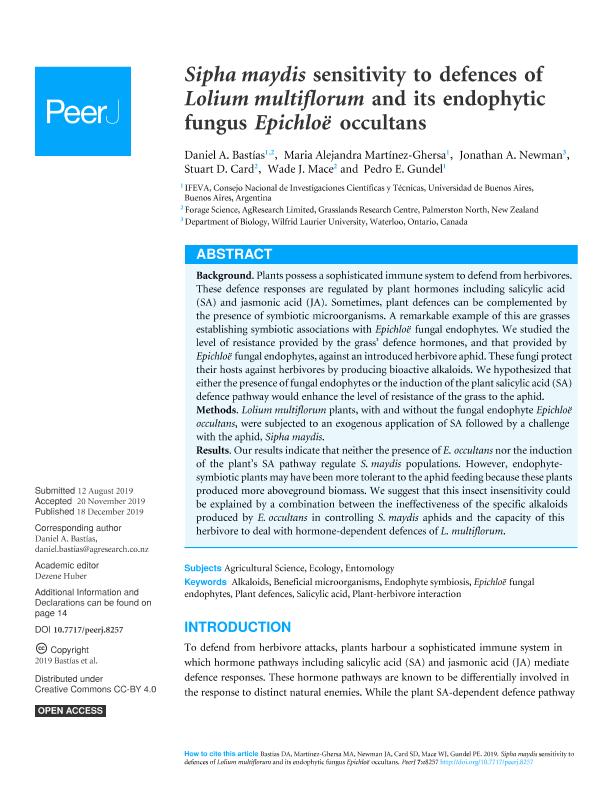Mostrar el registro sencillo del ítem
dc.contributor.author
Bastias, Daniel

dc.contributor.author
Martinez-Ghersa, Maria Alejandra

dc.contributor.author
Newman, Jonathan A.
dc.contributor.author
Card, Stuart D.
dc.contributor.author
Mace, Wade J.
dc.contributor.author
Gundel, Pedro Emilio

dc.date.available
2021-09-17T16:08:28Z
dc.date.issued
2019-12
dc.identifier.citation
Bastias, Daniel; Martinez-Ghersa, Maria Alejandra; Newman, Jonathan A.; Card, Stuart D.; Mace, Wade J.; et al.; Sipha maydis sensitivity to defences of Lolium multiflorum and its endophytic fungus Epichloë occultans; PeerJ Inc.; PeerJ; 7; e8257; 12-2019; 1-21
dc.identifier.issn
2167-8359
dc.identifier.uri
http://hdl.handle.net/11336/140718
dc.description.abstract
Background. Plants possess a sophisticated immune system to defend from herbivores. These defence responses are regulated by plant hormones including salicylic acid (SA) and jasmonic acid (JA). Sometimes, plant defences can be complemented by the presence of symbiotic microorganisms. A remarkable example of this are grasses establishing symbiotic associations with Epichloë fungal endophytes. We studied the level of resistance provided by the grass’ defence hormones, and that provided by Epichloë fungal endophytes, against an introduced herbivore aphid. These fungi protect their hosts against herbivores by producing bioactive alkaloids. We hypothesized that either the presence of fungal endophytes or the induction of the plant salicylic acid (SA) defence pathway would enhance the level of resistance of the grass to the aphid. Methods. Lolium multiflorum plants, with and without the fungal endophyte Epichloë occultans, were subjected to an exogenous application of SA followed by a challenge with the aphid, Sipha maydis. Results. Our results indicate that neither the presence of E. occultans nor the induction of the plant’s SA pathway regulate S. maydis populations. However, endophytesymbiotic plants may have been more tolerant to the aphid feeding because these plants produced more aboveground biomass. We suggest that this insect insensitivity could be explained by a combination between the ineffectiveness of the specific alkaloids produced by E. occultans in controlling S. maydis aphids and the capacity of this herbivore to deal with hormone-dependent defences of L. multiflorum.
dc.format
application/pdf
dc.language.iso
eng
dc.publisher
PeerJ Inc.
dc.rights
info:eu-repo/semantics/openAccess
dc.rights.uri
https://creativecommons.org/licenses/by/2.5/ar/
dc.subject
Alkaloids
dc.subject
Beneficial microorganisms
dc.subject
Endophyte symbiosis
dc.subject
Plant-herbivore interaction
dc.subject.classification
Agricultura

dc.subject.classification
Agricultura, Silvicultura y Pesca

dc.subject.classification
CIENCIAS AGRÍCOLAS

dc.title
Sipha maydis sensitivity to defences of Lolium multiflorum and its endophytic fungus Epichloë occultans
dc.type
info:eu-repo/semantics/article
dc.type
info:ar-repo/semantics/artículo
dc.type
info:eu-repo/semantics/publishedVersion
dc.date.updated
2020-12-15T14:16:00Z
dc.journal.volume
7
dc.journal.number
e8257
dc.journal.pagination
1-21
dc.journal.pais
Estados Unidos

dc.journal.ciudad
California
dc.description.fil
Fil: Bastias, Daniel. Consejo Nacional de Investigaciones Científicas y Técnicas. Oficina de Coordinación Administrativa Parque Centenario. Instituto de Investigaciones Fisiológicas y Ecológicas Vinculadas a la Agricultura. Universidad de Buenos Aires. Facultad de Agronomía. Instituto de Investigaciones Fisiológicas y Ecológicas Vinculadas a la Agricultura; Argentina. Grasslands Research Centre; Nueva Zelanda
dc.description.fil
Fil: Martinez-Ghersa, Maria Alejandra. Consejo Nacional de Investigaciones Científicas y Técnicas. Oficina de Coordinación Administrativa Parque Centenario. Instituto de Investigaciones Fisiológicas y Ecológicas Vinculadas a la Agricultura. Universidad de Buenos Aires. Facultad de Agronomía. Instituto de Investigaciones Fisiológicas y Ecológicas Vinculadas a la Agricultura; Argentina
dc.description.fil
Fil: Newman, Jonathan A.. Wilfrid Laurier University; Canadá
dc.description.fil
Fil: Card, Stuart D.. Grasslands Research Centre; Nueva Zelanda
dc.description.fil
Fil: Mace, Wade J.. Grasslands Research Centre; Nueva Zelanda
dc.description.fil
Fil: Gundel, Pedro Emilio. Consejo Nacional de Investigaciones Científicas y Técnicas. Oficina de Coordinación Administrativa Parque Centenario. Instituto de Investigaciones Fisiológicas y Ecológicas Vinculadas a la Agricultura. Universidad de Buenos Aires. Facultad de Agronomía. Instituto de Investigaciones Fisiológicas y Ecológicas Vinculadas a la Agricultura; Argentina
dc.journal.title
PeerJ
dc.relation.alternativeid
info:eu-repo/semantics/altIdentifier/url/https://peerj.com/articles/8257
dc.relation.alternativeid
info:eu-repo/semantics/altIdentifier/doi/http://dx.doi.org/10.7717/peerj.8257
Archivos asociados
